Overview
Chambers and valves of the heart
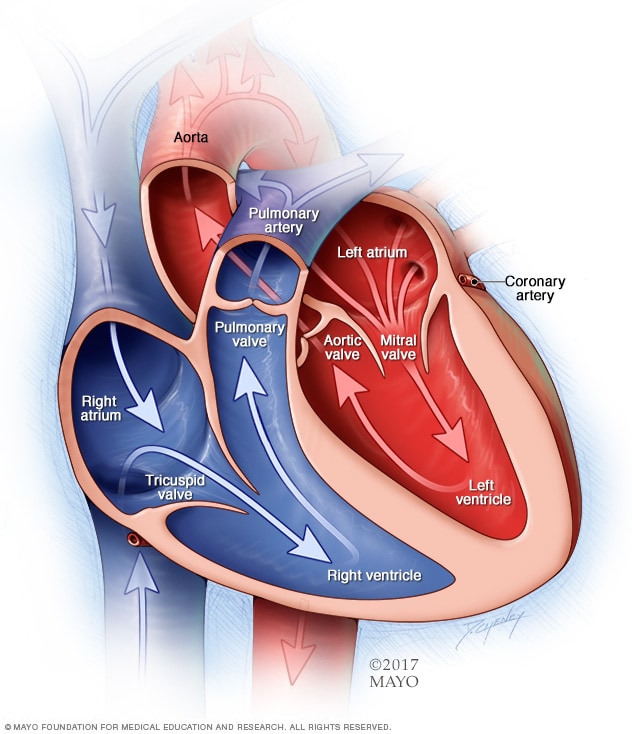
Chambers and valves of the heart
A typical heart has two upper and two lower chambers. The upper chambers, the right and left atria, receive incoming blood. The lower chambers, the more muscular right and left ventricles, pump blood out of the heart. The heart valves, which keep blood flowing in the right direction, are gates at the chamber openings.
Pulmonary valve repair and pulmonary valve replacement are procedures to treat a diseased or damaged pulmonary valve.
The pulmonary valve is one of four valves that control blood flow in the heart. It's between the lower right heart chamber (right ventricle) and the artery that delivers blood to the lungs (pulmonary artery).
A diseased or damaged pulmonary valve can interrupt blood flow from the heart to the lungs. Pulmonary valve repair and pulmonary valve replacement can help improve blood flow and reduce symptoms of heart valve disease.
Products & Services
Types
Why it's done
Pulmonary valve regurgitation
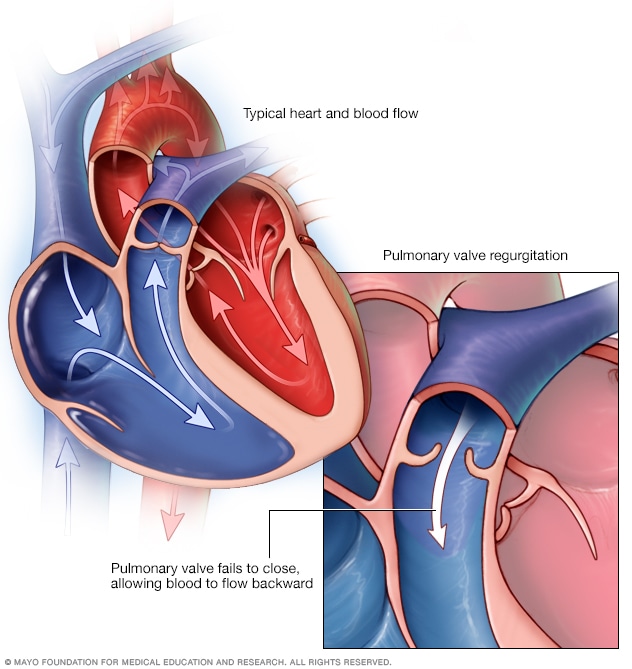
Pulmonary valve regurgitation
In pulmonary valve regurgitation, a leaky valve allows blood to flow backward into the heart rather than directly to the lungs for oxygen.
Pulmonary valve repair and pulmonary valve replacement are done to treat pulmonary valve disease.
Pulmonary valve disease is a condition in which the lung (pulmonary) valve doesn't work properly. It may occur on its own or with other heart conditions present at birth (congenital heart defects), such as tetralogy of Fallot.
Types of pulmonary valve disease that may require treatment with pulmonary valve repair or pulmonary valve replacement include:
- Pulmonary valve regurgitation. A leaky pulmonary valve allows blood to flow backward into the heart (pulmonary valve regurgitation) rather than directly to the lungs for oxygen.
- Pulmonary valve stenosis. The pulmonary valve is thickened or blocked. It's hard for the valve to open properly. The heart must work harder to pump blood into the pulmonary artery and to the lungs.
- Pulmonary atresia. This is a congenital heart defect in which a child is born without a well-defined pulmonary valve. In pulmonary atresia, blood can't flow from the right lower heart chamber into the lung artery. The only blood flow to the lungs is through an open passageway between the pulmonary artery and the body's main artery (aorta).
The decision to repair or replace a damaged pulmonary valve depends on many things, including:
- The severity (stage) of pulmonary valve disease
- Symptoms
- Age and overall health
- Whether or not the condition is getting worse
- Whether surgery is needed to correct another valve or heart condition
Pulmonary valve surgery may be done at the same time as other heart valve surgeries. In general, surgeons recommend pulmonary valve repair when possible, as it saves the heart valve and improves heart function.
Risks
All surgeries have risks. Risks of pulmonary valve repair and pulmonary valve replacement depend on your health, the type of procedure, and the expertise of the surgeons and other health care providers.
Potential risks of pulmonary valve repair and pulmonary valve replacement include:
- Bleeding
- Blood clots
- Failure of a replacement valve
- Heart attack
- Irregular heart rhythms (arrhythmias)
- Infection
- Stroke
- Death
How you prepare
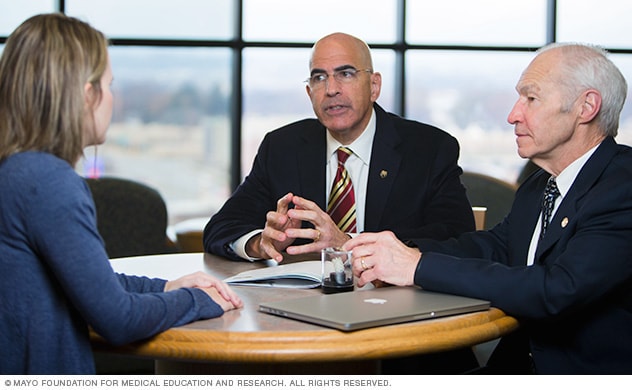 Pulmonary valve disease consultation at Mayo Clinic
Pulmonary valve disease consultation at Mayo Clinic
Your Mayo Clinic treatment team will discuss any questions you might have about your pulmonary valve repair or pulmonary valve replacement procedure at Mayo Clinic.
Before pulmonary valve repair or replacement, your health care providers will explain to you what to expect before, during and after the surgery and potential risks of the surgery.
Before being admitted to the hospital for your surgery, talk to your caregivers about your upcoming hospital stay. Discuss any help you may need when you return home.
Food and medications
Talk to your health care providers about:
- When or if you can take your regular medications before surgery
- When or if you should stop eating or drinking the night before surgery
Clothing and personal items
Your health care providers may recommend that you bring several items to the hospital, including:
- A copy of your advance directive or living will
- A list of your medications
- Eyeglasses, hearing aids or dentures
- Items that may help you relax, such as portable music players or books
- Loose-fitting, comfortable clothing
- Personal care items, such as a brush, comb, shaving equipment and toothbrush
Don't wear:
- Contact lenses
- Dentures
- Eyeglasses
- Jewelry
- Nail polish
What you can expect
During the procedure
When you arrive for surgery, a care provider will insert an IV into your forearm or hand. Fluids and medicines can be given through the IV. A care provider may shave off any hair at the location where the procedure will take place.
For most pulmonary valve repair and replacement procedures, you'll receive medications (general anesthesia) that put you in a sleep-like state so you won't feel any pain during the surgery.
You may be connected to a heart-lung bypass machine. The machine keeps blood moving through the body during the heart valve surgery.
Pulmonary valve repair
Pulmonary valve repair is usually done with open-heart surgery and by opening of the chest bone (sternotomy). Surgeons wire the bone back together after the procedure to prevent movement and aid in healing.
Pulmonary valve repair involves:
- Separating valve flaps that have fused
- Creating one or more new valve leaflets from your own heart tissues
- Removing any patches that may have been placed during earlier congenital heart disease surgeries and bringing the pulmonary valve leaflets together to create a working valve
- Reshaping or removing tissue to allow the valve to close more tightly
- Tightening or reinforcing the ring around the valve (annulus)
Minimally invasive pulmonary valve repair
If the pulmonary valve can't fully open due to pulmonary valve stenosis, a less invasive procedure called balloon valvuloplasty may be used to repair the valve. Minimally invasive heart valve surgery typically involves smaller incisions and a shorter hospital stay than traditional open-heart surgery.
During balloon valvuloplasty, a surgeon inserts a thin, hollow tube (catheter) into a blood vessel, usually in the groin, and threads it to the heart. A balloon on the tip of the catheter is inflated, which widens the narrowed pulmonary valve. The balloon is deflated and removed.
Balloon valvuloplasty is often used to treat infants and children with pulmonary valve stenosis. However, the valve tends to narrow again in adults who have had the procedure. Additional procedures may be needed to treat the narrowed valve over time.
Pulmonary valve replacement
Pulmonary valve replacement: Biological valve
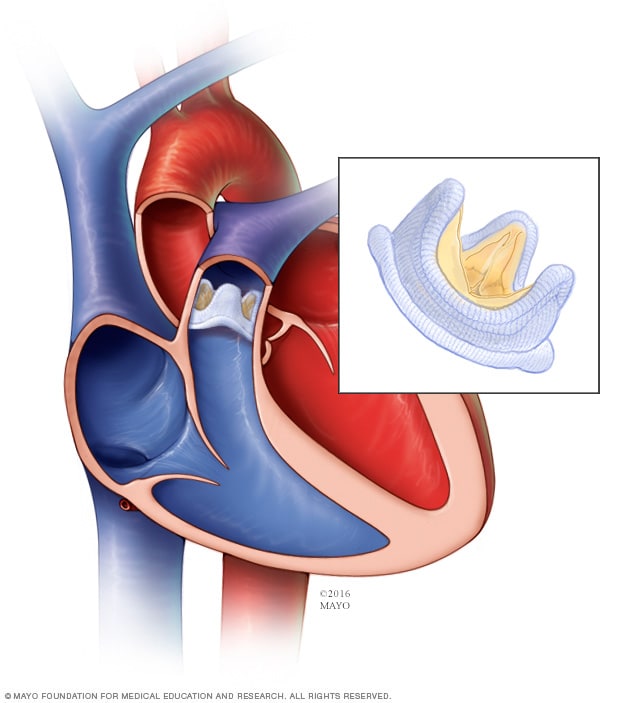
Pulmonary valve replacement: Biological valve
In a biological pulmonary valve replacement, a valve made from cow, pig or human heart tissue replaces the damaged valve.
If the pulmonary valve can't be repaired, surgery may be needed to replace the valve. In this procedure, a surgeon removes the pulmonary valve and replaces it with a mechanical valve or a valve made from cow, pig or human heart tissue (biological tissue valve).
If you have a mechanical valve, you'll need to take blood-thinning medications for life to prevent blood clots. Biological valves often eventually need to be replaced, as they break down over time. Together, you and your health care providers will discuss the risks and benefits of each type of valve to choose the one that's best for you.
Pulmonary valve replacement may be done using open-heart surgery or minimally invasive methods, which involve smaller incisions than those used in open-heart surgery.
Minimally invasive pulmonary valve replacement
Pulmonary valve-in-valve replacement
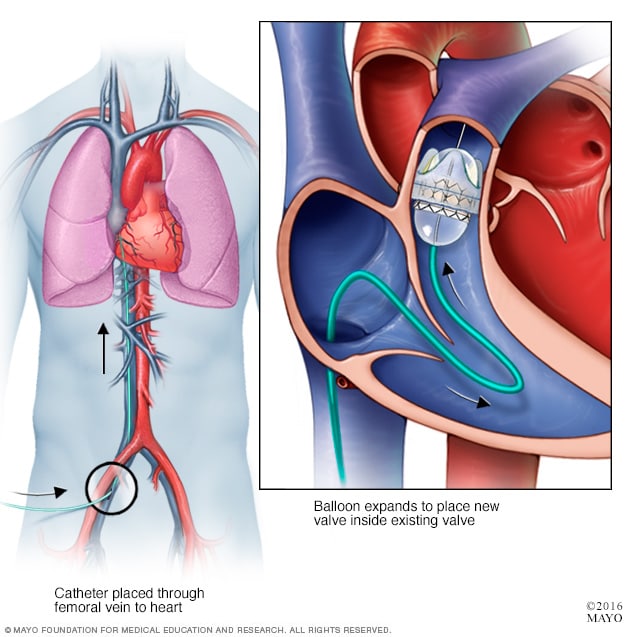
Pulmonary valve-in-valve replacement
In a transcatheter valve-in-valve procedure, a heart surgeon inserts a thin, hollow tube (catheter) into a blood vessel, usually in the groin. The catheter is then guided to the heart. A replacement valve goes through the catheter. A balloon on the tip of the catheter expands to press the new valve into the existing pulmonary valve.
Minimally invasive pulmonary valve replacement helps reduce the number of open-heart surgeries over a person's lifetime. The most common type of minimally invasive pulmonary valve replacement is transcatheter pulmonary valve replacement, also called percutaneous pulmonary valve replacement.
In this type of pulmonary valve replacement, the surgeon inserts a thin, flexible tube (catheter) into a large blood vessel in the groin or chest and guides it to the heart. A replacement pulmonary valve goes through the catheter. A balloon on the tip of the catheter expands to press the new pulmonary valve into place.
A transcatheter procedure also may be used to insert a new pulmonary valve in a previously replaced valve that's now failing. This is called a valve-in-valve procedure.
After the procedure
After open-heart pulmonary valve repair or pulmonary valve replacement, you'll generally spend a day or more in the intensive care unit (ICU).
You'll be given fluids, nutrition and medications through intravenous (IV) lines. Other tubes will drain urine from your bladder and drain fluid and blood from your heart and chest. You may be given oxygen.
After the ICU, you'll be moved to a regular hospital room for a few days. The time you spend in the ICU and hospital can vary, depending on your condition and procedure.
During your hospital stay, your treatment team will:
- Watch for signs of infection in your incision sites
- Periodically check your blood pressure, breathing and heart rate
- Work with you to manage any pain you have after surgery
- Instruct you to walk regularly to gradually increase your activity and do breathing exercises as you recover
You'll receive instructions to follow during your recovery, such as watching for signs of infection in your incisions, properly caring for incisions, taking medications, and managing pain and other side effects after your surgery.
Recovery time depends on the specific procedure, your overall health before the procedure and any complications.
Results
After pulmonary valve repair or pulmonary valve replacement surgery, your health care provider will tell you when you can return to daily activities, such as working, driving and exercise.
You'll need regular health checkups to monitor your heart condition and to check for complications, such as valve failure. Imaging tests may be done to make sure the pulmonary valve is working correctly.
After heart valve surgery, it's important to follow a heart-healthy lifestyle. Your health care provider may recommend these lifestyle changes:
- Getting regular exercise
- Controlling weight
- Eating a healthy diet
- Managing stress
- Not smoking
Your care provider may also suggest participating in a program of education and exercise — called cardiac rehabilitation — to improve your overall health and help you recover after pulmonary valve surgery.
The results of pulmonary valve repair and replacement depend largely on the skill and expertise of the surgeons and medical center. If you need pulmonary valve repair or replacement, consider being treated at a medical center with a multidisciplinary team of heart surgeons and care providers trained and experienced in heart valve surgery.
Clinical trials
Explore Mayo Clinic studies of tests and procedures to help prevent, detect, treat or manage conditions.